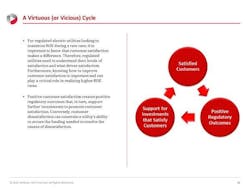Critical Role of Customer Connect in Changing Utilities Environment
It’s a tough time to be a utility. While the headlines have been dominated over the past several months with the plight of PG&E, which was just cleared of criminal charges for its role in the 2017 Sonoma County wildfires, but still faces a raft of liabilities for its role in the devastating 2018 Camp Fire, the problems run much deeper than any one utility’s experience.
A perfect storm of disruption, driven by aging infrastructure, rising demand, environmental volatility and growing consumer expectations for consumer-like digital experiences is challenging utilities like never before.
While addressing these challenges will require a significant undertaking — and in the case of PG&E — crippling costs, the situation does create an opportunity for utilities to strengthen their relationships with customers. Ultimately, how well utilities manage that customer relationship through this challenging period could determine their future viability.
Customer Satisfaction Key to Future Profitability
That may sound like a strange proposition for utility executives staring down potentially billions in infrastructure redevelopment and technology upgrades. After all, how can they possibly worry about improving customer satisfaction at a time when they are so capacity-constrained? Because their rate cases and future price increase depend on it.
When customers feel good about their utilities, rate cases are approved and price increases become much easier to digest. When they feel slighted, the outcome is much less certain. These dynamics apply to both public- or member-owned utilities and investor-owned utilities.
Perhaps not surprisingly, then, the surest path to an approved rate case or a smooth transition to price increases is having a customer base that is delighted with the service a utility provides. J.D. Power proved this phenomenon in a study we conducted a few years ago, which found that higher levels of customer satisfaction one year prior to a rate case are associated with higher levels of return on equity for a regulated utility.
Cracking the Code on Customer Satisfaction
Taking things one step further, our research has also shown that – in the current environment, where consumers have been inundated with news about lapses in safety among major utilities – customer awareness of safety initiatives has a high correlation with customer satisfaction.
Among electric utility customers in our syndicated customer satisfaction studies, awareness of utility efforts to increase safety is associated with a 112-point increase (on a 1,000-point scale) in total satisfaction. For residential gas customers, perception of the utility’s level of helpfulness in preparing for a safety issue is associated with a 121-point increase in customer satisfaction. Among water utility customers, the belief that the utility maintains its current infrastructure is associated with a 225-point increase in total satisfaction.
Beyond the safety issue, another big challenge confronting utilities right now is meeting current customer demand for user-friendly tech that is in line with what they’ve come to expect from their banking and credit card digital apps and other mainstream consumer technologies.
Accordingly, many utilities are investing heavily in technology systems upgrades that will allow them to instantly text customer alerts, allow customers to manage their usage and billing, and interact with customer support digitally.
Getting this formula right is critical for utilities as digital communication channels rapidly become the preferred means of customer communication. According to the 2018 J.D. Power Electric Utility Residential Customer Satisfaction Study, customers who interacted with customer service via online, text, e-mail, chart, and social media channels, all had higher levels of satisfaction than those who interacted via a live customer service representative.
These are not the kinds of initiatives that can be implemented overnight. Major infrastructure, technology, and safety initiatives like these can take decades to fully develop. But taking initial steps now to increase customer communications, clearly convey goals and direction, and reporting steady, incremental progress toward those goals is key to setting the stage for an engaged relationship with customers that will pay dividends in the future
About the Author
Andrew Heath
Dr. Andrew Heath is the Managing Director of the Utility Practice and Senior Director of utilities intelligence at J.D. Power. He is responsible for J.D. Power’s water, natural gas, and electric customer satisfaction studies in the United States and Canada, as well as the company’s Utility Digital Experience Study. Dr. Heath has more than 30 years of experience working within the utility and infrastructure sectors in both the United States and the UK.

